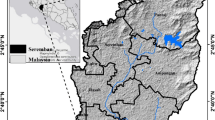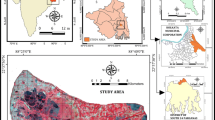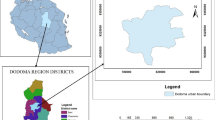Abstract
Cities and their problems in our world today are very important because they can affect the land uses and landscapes around them and make them change. Researchers have been tried to solve these problems using several methods. One way that can be useful in planning is simulation and prediction land use changes according to the parameters that affect changes in land use over the time. In this study, changes in land use of Bojnord city (the capital city of North Khorasan province), were considered and studied. In this regard, the CA–Markov model was used. In this model, suitability maps are the basis of the land use changes transformation. To produce suitability maps in this study, agricultural lands were paid specially attention and suitability of them has been reduced as much as possible in modeling. The land use maps of two different periods of time were used to calibrate the models. To validate the model, the “Validate” method (which is a statistical method to validate models) was used. The calculated kappa coefficients for both models were over 85%. In next step, changes of land use have been simulated until the year of 2050. Examination of the output maps which are obtained by CA–Markov model shows that the most growth in land use is in the built-up areas. In 2050, the built-up areas would grow 5.3% compared to 2009 and in subsequent periods the growth rate would be 3.5% on average.








Similar content being viewed by others
References
Aithal BH, Vinay S, Ramachandra TV (2018) Simulating urban growth by two state modelling and connected network. Model Earth Syst Environ 4:1297
Canadian Soil Information Service (2013). http://sis.agr.gc.ca/cansis/index.html
Clark Labs (2006) IDRISI tutorial
Dadras M, Shafri HZM, Ahmad N, Pradhan B, Safarpour S (2015) Spatiotemporal analysis of urban growth from remote sensing data in Bandar Abbas city, Iran, Egypt. J Remote Sens Sp Sci 18:35–52
Eastman JR (2006) Clark University, Worcester, MA
Eastman JR, Jiang H, Toledano J (1998) Multi-criteria and multi-objective decision making for land allocation using GIS. In: Beinat E, Nijkamp P (eds) Multi-criteria analysis for land-use management. Kluwer Academic Publishers, Dordrecht, pp 227–251
Feng Y, Yan L, Tong X, Liu M, Deng S (2011) Modeling dynamic urban growth using cellular automata and particle swarm optimization rules. Landsc Urban Plan 102:188–196
Guan D, Li H, Inohaec T, Sud W, Nagaiec T, Hokao K (2011) Modeling urban land use change by the integration of cellular automaton and Markov model. Ecol Model 222:3761–3772
Hu Z, Lo CP (2007) Modeling urban growth in Atlanta using logistic regression. Comput Environ Urban Syst 31:667–688
Liu Y, Phinn S (2003) Modelling urban development with cellular automata incorporating fuzzy-set approaches. Comput Environ Urban Syst 27:637–658
Malczewski J (1998) GIS and multicriteria decision analysis. Wiley, Oxford
Mitsova D, Shuster W, Wang X (2011) A cellular automata model of land cover change to integrate urban growth with open space conservation. Landsc Urban Plan 99:141–153
Nasehi S, Imanpour namin A, Salehi E (2019) Simulation of land cover changes in urban area using CA-MARKOV model (case study: zone 2 in Tehran, Iran). Model Earth Syst Environ 5:193
Novin MS, Khosravi F (2017) Simulating urban growth by emphasis on connective routes network (case study: Bojnord city). Egypt J Remote Sens Sp Sci 20(2017):31–40
Rabbani G, Shafaqi S, Rahnama MR (2018) Urban sprawl modeling using statistical approach in Mashhad, northeastern Iran. Model Earth Syst Environ 4:141
Rawat JS, Biswas V, Kumar M (2013) Changes in land use/cover using geospatial techniques: a case study of Ramnagar town area, district Nainital, Uttarakhand, India, Egypt. J Remote Sens Sp Sci 16:111–117
Author information
Authors and Affiliations
Corresponding author
Additional information
Publisher's Note
Springer Nature remains neutral with regard to jurisdictional claims in published maps and institutional affiliations.
Rights and permissions
About this article
Cite this article
Novin, M.S., Ebrahimipour, A. Spatio-temporal modelling of land use changes by means of CA–Markov model. Model. Earth Syst. Environ. 5, 1253–1263 (2019). https://doi.org/10.1007/s40808-019-00633-8
Received:
Accepted:
Published:
Issue Date:
DOI: https://doi.org/10.1007/s40808-019-00633-8




